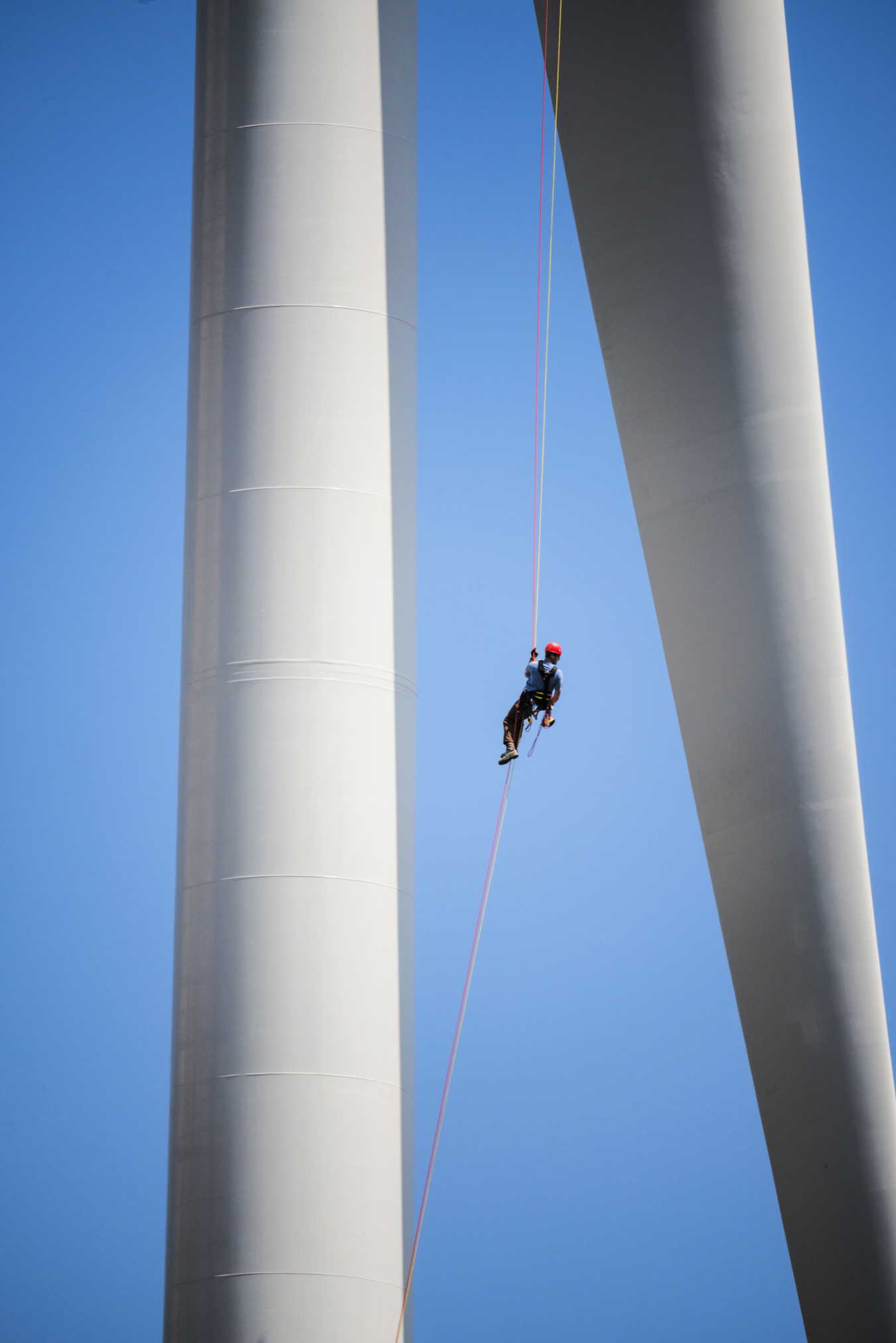Researchers are analyzing alternative blade concepts that could almost double the size of today’s blades.
Wind Energy Technologies Office
October 21, 2019Researchers do the math on innovative blade configurations
Scientists at DOE’s National Renewable Energy Laboratory (NREL) and Sandia National Laboratories (Sandia) are searching for ways to maximize the advantages of large-scale rotors and their potential for increased energy generation. Their work as part of DOE’s Big Adaptive Rotor (BAR) project aims to develop 5-MW land-based turbines with 206-meter (m) rotors.
This article is part of the
Basic math can easily explain the benefits of larger turbines. To sum it up, bigger equals better.
Bigger blades can sweep larger areas and access faster wind speeds available at higher heights above the ground. Capturing more of the wind and tapping into better wind resources help drive down the cost of energy. Rotor growth may also increase capacity factors, or the amount of power a turbine outputs on average over the course of a year. In some circumstances, higher capacity factors may increase the value of wind energy to the electricity system.
Yet, bigger blades also face transportation and manufacturing challenges that prevent scaling turbines up to sizes needed to deliver additional cost-of-energy advantages.
“One of the major constraints we’re dealing with when creating larger rotors is the weight of the blades,” said Nick Johnson, an NREL research engineer and principal investigator on the five-year, multilab BAR project. “Longer blades are heavier, and more weight translates into more cost.”

DOE’s Big Adaptive Rotor project aims to develop 5-MW land-based turbines with 206-meter rotors, which will capture more wind and drive down the cost of energy. Photo by NREL
A BAR study led by Lawrence Berkeley National Laboratory and DNV GL worked to address the relationship among bigger blades, weight, and transportation. The study identified the development of innovative transportation modes, segmented blades, and on-site manufacturing methods as critical needs in advancing the next generation large rotors.
This foundational study guided NREL and Sandia researchers in their exploration of five promising rotor design options. The first concept features a nacelle that has been rotated 180 degrees to operate the rotor downwind of the tower. This configuration allows for increased tower clearance and lower blade mass, because more flexible blades are possible when the wind pushes the blades away from the tower.
The BAR team is exploring another weight-reducing strategy referred to as distributed aerodynamics control. This design approach mechanically changes the shape of the blades, much like an airplane wing during take-off and landing, to reduce both fatigue and extreme loads. While offering a potential solution for flutter issues on longer, more flexible blades, this concept introduces challenges in relation to factors such as controls, manufacturing, and reliability.

Downwind turbines like the one shown here could allow for taller turbines and longer blades because the wind pushes the blades away from the tower, enabling increased tower clearance. Graphic by NREL
The multielement airfoil and the 4-/5-bladed rotor move further away from conventional turbine designs to address transportation limitations. The multielement airfoil, which bears some resemblance to old biplane wings, could improve aerodynamic performance, boost structural integrity, and come together using a segmented approach. The 4-/5-bladed option allows for thinner, lighter blades with reduced loading and presents transportation advantages.
At the extreme end of the lightweight spectrum, the BAR team is also exploring a blade concept that involves an inner structure that can be segmented or manufactured on-site, potentially incorporating advanced manufacturing techniques similar to 3D printing, and filled with a suitable material, such as rigid foam, to achieve the desired aerodynamic profile.
The BAR team is using NREL’s primary turbine design models, OpenFAST and WISDEM, which model turbine performance and turbine system-level interactions respectively, to evaluate each concept.
After determining the two or three top options through computational analysis, BAR researchers will undertake detailed design studies to determine how supersized blades of the future could add up to sizable cost savings.
-
 A new scalable offshore floating wind system provides novel solutions to cut costs and overcome challenges of deepwater offshore environments.
A new scalable offshore floating wind system provides novel solutions to cut costs and overcome challenges of deepwater offshore environments. -
 A2e initiative addresses the need to have reliable, applicable wind data by establishing and funding the Data Archive and Portal (DAP).
A2e initiative addresses the need to have reliable, applicable wind data by establishing and funding the Data Archive and Portal (DAP). -
System operators have a new tool for bringing intuition to the deluge of wind data—a visualizer for wind power forecasts called WindView.
-
 Offshore wind representatives met this spring to discuss meteorology and oceanography research to support offshore wind projects in the U.S.
Offshore wind representatives met this spring to discuss meteorology and oceanography research to support offshore wind projects in the U.S. -
 With a host of new partners and an open call for research proposals, the $41-million National Offshore Wind R&D Consortium is ready to make a splash.
With a host of new partners and an open call for research proposals, the $41-million National Offshore Wind R&D Consortium is ready to make a splash.
Explore previous editions of the Wind R&D Newsletter or browse articles by topic:

